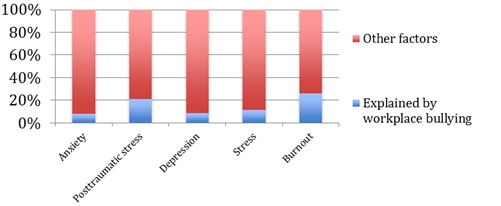Just joking! …?! – Workplace bullying and mental health
Half a million people have suffered from bullying at work in the past year. And 80,000 of these people have been structurally humiliated, excluded, verbally abused, or threatened (TNO). What do we know about how workplace bullying affects our health?
How does bullying in the workplace contribute to mental health problem?
Being part of the group, feeling valued, and feeling supported are fundamental human needs. Human beings are social animals; belonging to a group helps us feel safe. Being bullied at work seriously jeopardizes our sense of safety. Employees who are bullied are constantly on the lookout for danger. Feelings of being unsafe trigger a stress response in the body, so the bodies of these employees are always on high alert. Even when they’re at home they find it hard to leave their experiences of bullying behind them; their worries pursue them. If this situation goes on too long it can lead to changes in all sorts of bodily processes designed to ensure a balance in our bodies. Ultimately this can cause damage and give rise to physical or psychological problems, or both.
As yet, however, only limited research has been carried out into how workplace bullying can lead to health problems, and into methods for preventing this bullying from taking place and countering its effects.
Figure 1 - Explained variance in mental health problems as a result of bullying
Figure 1 shows that 15% of the variation in mental health problems is explained by bullying at work. The remaining variation variance may be due to the factors mentioned above, genetic disposition, learning experiences, or other environmental factors.
Relationship between workplace bullying and health
Scientific research into the relationship between workplace bullying and health got underway in the late 1990s. Recently we (Marc L. Molendijk, Serpil Atasayi and I) carried out a meta-analysis of the research into workplace bullying and mental health, collecting together all the research literature that has investigated this relationship. We included both studies in which workplace bullying and mental health were measured at the same time (single measurement) and studies in which employees were followed for several months or years (measurements at two points in time). This allowed us to examine whether there was a connection between bullying at work and mental health problems, and also whether this bullying at work contributed to the worsening – or the emergence – of such problems. Summarizing a large number (65) of studies provides more reliable information than an individual study.
Two-way effect
As you might expect, bullying at work was associated with various mental health problems (anxiety, posttraumatic stress symptoms, depressive symptoms, stress, and burnout). Bullying at work also contributed to a worsening of these problems in the long term. Interestingly enough, people who suffered from increased anxiety and stress problems also had a higher risk of experiencing bullying again in the future. So the association works both ways: bullying at work contributes to mental health problems, but people with mental health problems also run a higher risk of being bullied.
Did we find these associations exclusively in certain subgroups?
No. Bullying at work was clearly associated with mental health problems, regardless of the employee’s age or gender, or the type of work involved.
There was a clear, consistent association, but was it a strong association?
The relation between bullying at work and mental health problems was just as strong (or large) as the relation with other, better known predictors of mental health problems, such as being overweight, not getting enough exercise, losing one’s job, or getting divorced.
Bullying and social status
One of the explanations given for bullying at work is that the bully – whether a colleague or a boss – is out to protect his or her own social status. Research published by Albert Reijntjes in 2013 about bullying at school shows that bullies are often very popular. So is this a specifically human characteristic, this emphasis on social status? Not a bit of it. It’s more an animal instinct. The biologist Robert Sapolsky shows that baboons (social animals that live together in strongly hierarchical groups) “bully” each other to bolster their social status in the group. Watch this film for an illustration: a baboon loses a fight (a power struggle) and subsequently takes a swipe at a lower-ranking baboon, who then lashes out at a baboon of lower rank again, who in turn takes it out on one even lower down the chain… etc. etc. And it is particularly the animals of the lowest rank of all that demonstrate the highest levels of stress hormones in their systems. Incidentally, where workplace bullying is concerned, we’re talking not about once-off confrontations, but precisely about persistent, systematic forms of threat.
Sapolsky on social status, aggression and stress in baboons.
(Translation: Maria Sherwood)
Further reading:
- Reijntjes, A., Vermande, M., Olthof, T., Goossens, F. A., van de Schoot, R., Aleva, L., & van der Meulen, M. (2013. Costs and benefits of bullying in the context of the peer group: A three wave longitudinal analysis. Journal of Abnormal Child Psychology, 41(8), 1217-1229.
- TNO: Kwart van de werknemers ooit gepest
- Verkuil, B., Atasayi, S., & Molendijk, M. L. (2015). Workplace bullying and mental health: a meta-analysis on cross-sectional and longitudinal data. PloS One, 10(8), e0135225.






